Optometry Practice: Good Communication and Patient Retention
This article discusses the importance of good communication and how it ensures that the patient keeps returning to you for their eye care.
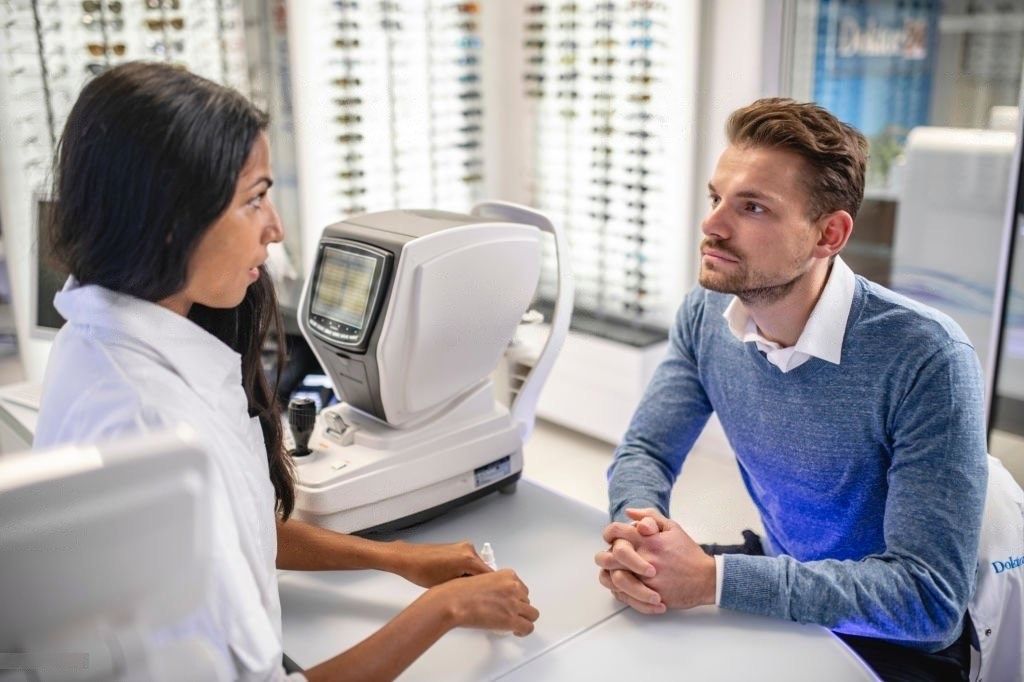
This article discusses the importance of good communication and how it ensures that the patient keeps returning to you for their eye care.
The evolution of Practitioner-Patient Communication
The healthcare practitioner and patient relationship dates back millenia, whether it was Ayurveda, traditional Chinese medicine or the ancient Egyptians. Just as the diagnoses and treatments have evolved, so has the way practitioners and patients communicate with each other.
Up until the last two centuries, communication was based more around the medical aspects of the patient's condition, rather than how the condition affects the patient as an individual. The former approach meant that the patient's role was passive, where the practitioner would dominate the conversation without offering options and the patient would quietly listen. The therapy would be decided up solely by the practitioner completely based on the diagnosed condition, without accommodating the patient's daily lifestyle requirements. The practitioner would do most of the talking, prescribe the therapy and send the patient packing. The outcome of this style of communication was that the patient would never question the practitioner, but at the same time was unlikely to adhere to the prescribed treatment if it significantly affected his or her quality of life.
Patient adherence to prescribed therapies is still an ongoing challenge in health care and the most common cause of lack of adherence is that the patient did not fully understand the importance of the therapy, or that it negatively affects their quality of life. Therefore a more evolved, patient-centric approach is required while communicating with patients. For starters, rather than the practitioner talking AT the patient, it is important to talk TO the patient. A conversation, where the patient feels free to ask questions and is given various therapy options with pros and cons of each, makes the patient feel included and it is a joint decision between the patient and the practitioner. The practitioner is considerate of the patients daily lifestyle requirements and ensures that the prescribed therapy or treatment is customised to accommodate that. The practitioner talks less and listens more, empowering the patient to communicate their fears and doubts.
A patient-centric approach to communication and building a good rapport results in a high level of trust in the practitioner as well as patient satisfaction. The patient will leave your practice feeling confident, with the intention to comply. When the patient adheres to the prescribed treatment / therapy and has a positive outcome, it is beneficial for both patient and practitioner, where the patient's problem is solved without hampering their quality and the practitioner has gained a patient for life.
Apathy, Sympathy and Empathy
Apathy, sympathy and empathy are three similar sounding words with very different meanings and any human from a small child to a wise elderly woman can detect these emotions simply from a tone of voice and a facial expression.
Apathy: "The feeling of not being interested in or enthusiastic about something, or things in general"
Sympathy: "The feeling of being sorry for someone"
Empathy: "The ability to understand another person's feelings or experience"
Even the best clinicians in the world will not be successful practitioners if they have an apathetic approach to their patients. Patient-centric care requires some degree and sympathy and on the most part, empathy. Empathy can be regarded in three different ways: Cognitive, Emotional and Compassionate. As a practitioner, demonstrating cognitive and compassionate empathy is most effective, the former referring to the ability to put oneself in another person's place and see their perspective, the latter refers to the ability to feel the other person's strife and take action to help. A sympathetic and empathetic approach to communication conveys the message that the practitioner understands what the patient is going through and cares.
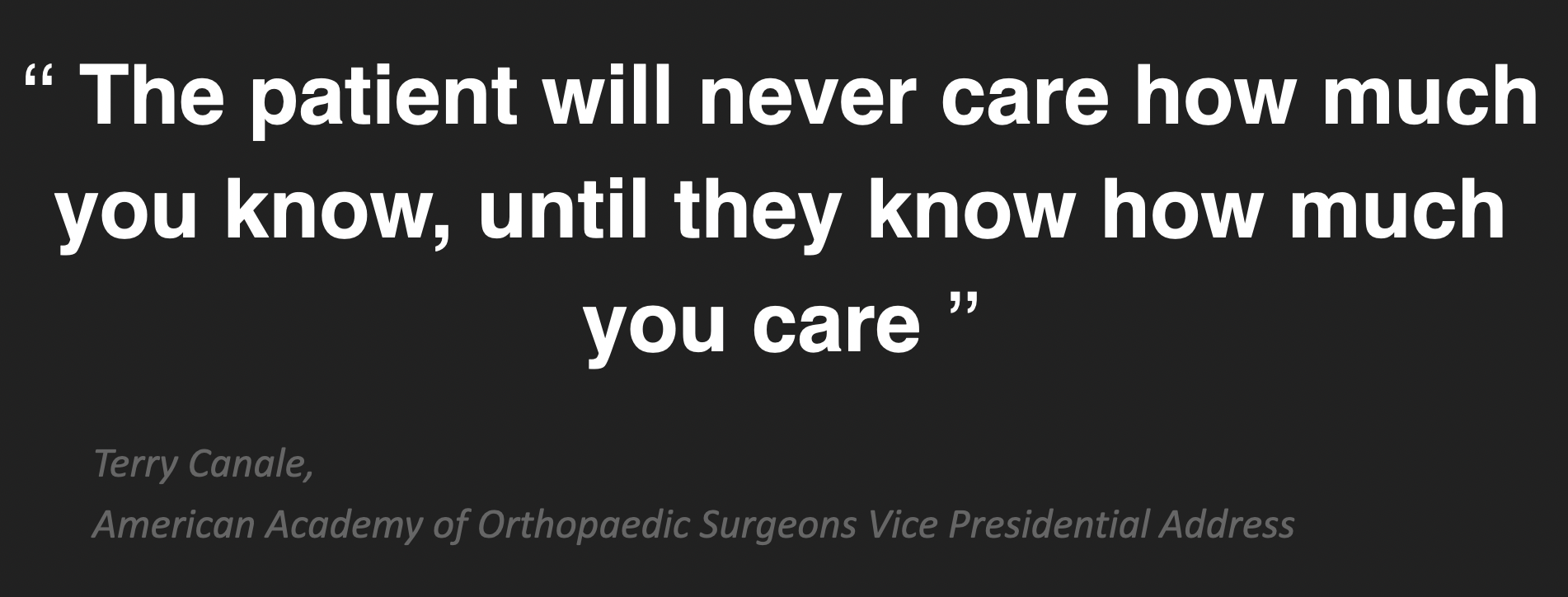
Steps for effective communication:
- Assess what the patient already knows: With all information being available at our fingertips, patients are fairly well informed and may or may not have done their research before attending.
- Assess what the patient wants to know: It is easy to make generalised assumptions, while the patient might be trying to communicate something very specific. Open ended questions give the patient the opportunity to articulate their needs. For example "how can I help you today?" or "Tell me more about..."
- Be empathetic
- Slow down and listen: Listening is key. A patient may casually mention something potentially serious without realising the seriousness, something that is easily missed if the practitioner wasn't listening. Having said that, time is money and you must recognise when to gently steer the conversation away from irrelevant details.
- Adapt language based on the patient’s intellectual and socio-economic level: Keep it simple WITHOUT insulting the patient’s intelligence
- Be truthful: Giving bad news is never easy, but it is important to always tell the WHOLE truth to protect both yourself and the patient.
- Be hopeful
- Be weary of the patient’s expressions and body language
- Be prepared for a reaction
Non-Verbal Communication
Non-verbal communication refers to body language and facial expressions as well as the tone of voice. Body language experts have shown that body language and facial expressions account for 55% of effective communication, tone of voice accounts for 38% while words account for only 7%. Apathy, sympathy and empathy are detected in the tone of voice and the body language and can be a deciding factor on whether or not the patient trusts you. Good body language practices include:
- Nodding
- Positioning the body to face the patient
- Not making excessive hand gestures while the patient is talking: This can be distracting for the patient and indicate that you are not listening.
- Facial Expression: Try and stick to positive facial expressions and avoid looking shocked or disgusted at all costs.
- Maintaining eye contact
- Smiling: The patient will feel reassured and comfortable and freely open up to you.
Optometric Practices
History Taking: As soon as the patient walks into your consulting room, there must be a clear, confident, friendly introduction and always direct the patient where to sit and where to place their items (phones, bags, spectacles, etc.). These seemingly small gestures help put the patient at ease, particularly if they are new and in an unfamiliar environment. As mentioned before, open-ended questions are the best way to extract accurate information from the patient, eg. "How are you?", "How can I help you today?", "Why have you come to visit me today?" If is is an existing patient, ensure that you have carefully read their previous records and recall information from there, eg. "Are you still playing tennis?", this will put the patient at ease because it will confirm that you are completely familiar with them as an individual and familiar with their case history. The history taking section of the eye examination is a conversation NOT an interrogation. Most importantly, keep engaging with the patient, even while entering data into the patient record. Finally, always finish with "Is there anything else you wanted to tell me?", allowing the patient to run a mental check list and ensure they have not missed anything.
Clinical Examination:
- Give CLEAR instructions
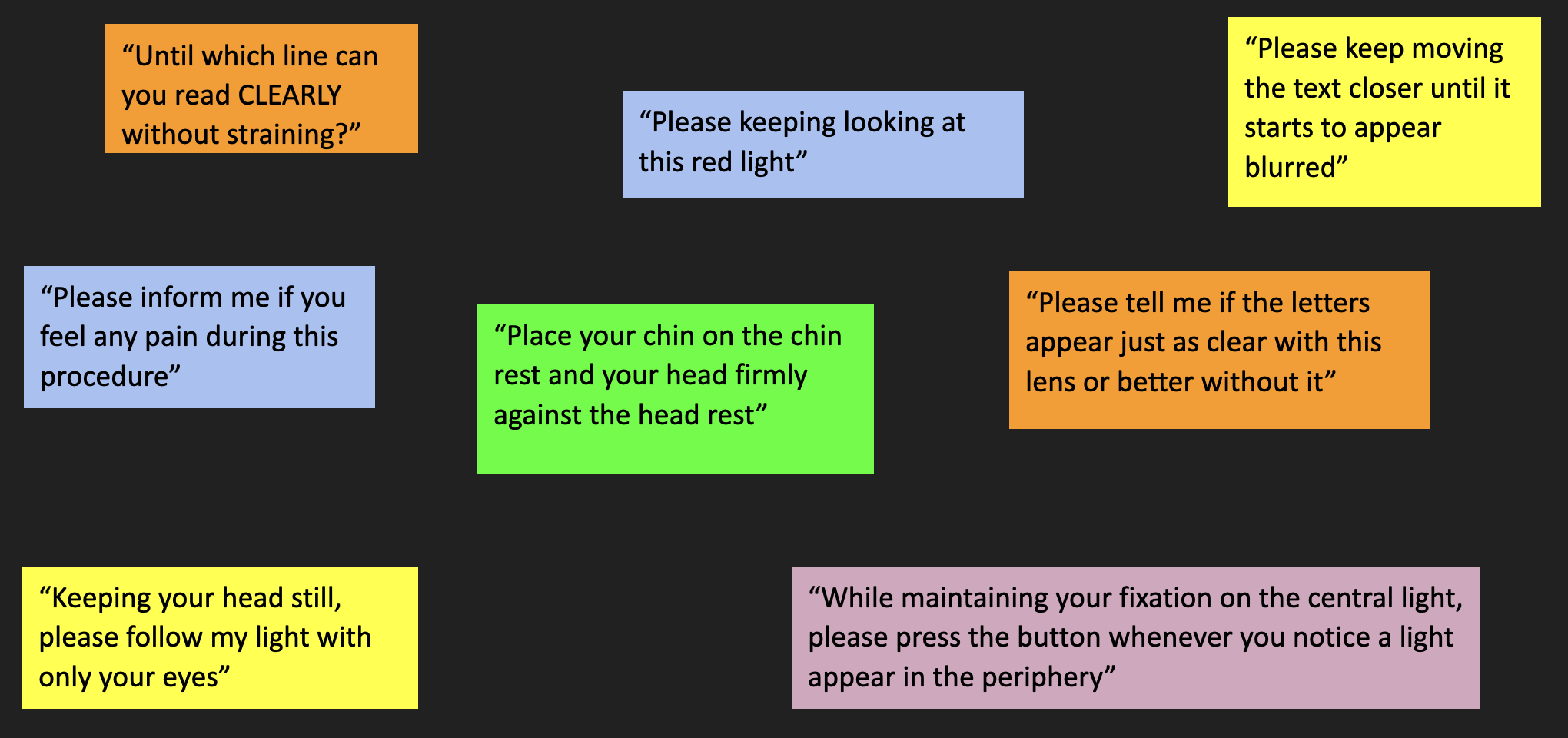
2. Keep the patient informed THROUGHOUT the examination
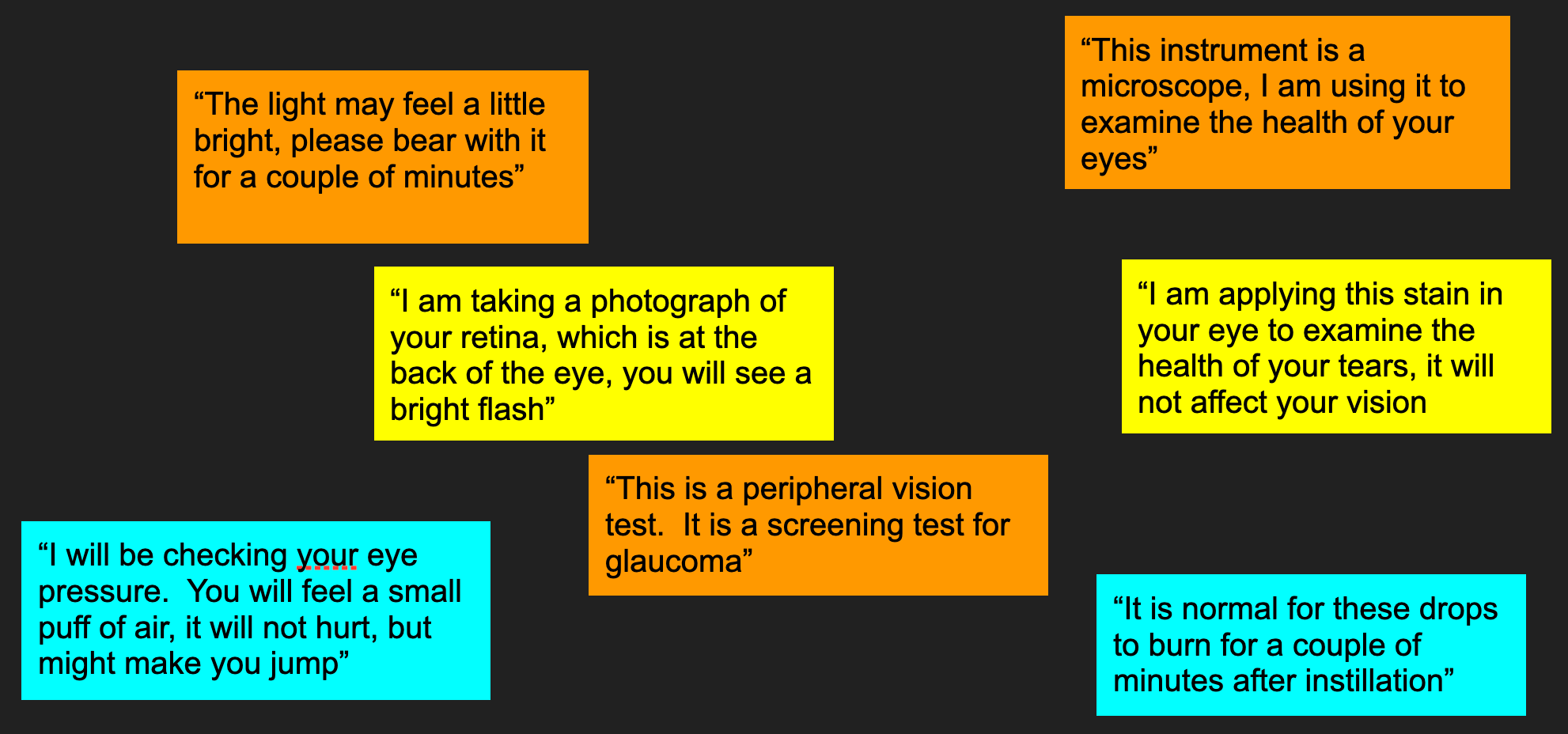
3. Keep checking in and reassuring
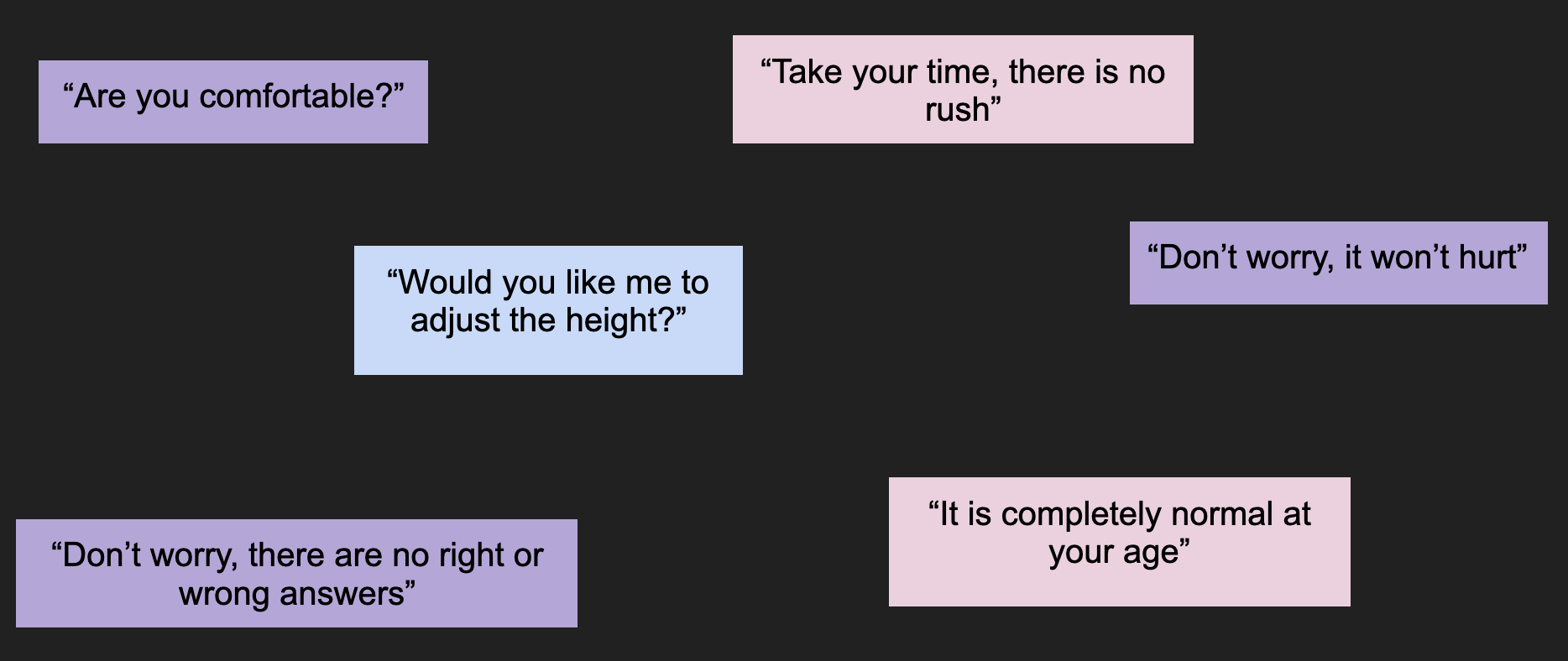
Action and Advice: DISCUSS your findings with the patient preferably with the use of visual aids to explain. It is important to relate findings to initial complaint or query. DISCUSS your plan of action moving forward, whether it is further tests, referral to a specialist, simply prescribing spectacles or any other treatment or therapy. Give the patient an opportunity to ask questions and ENSURE that they have fully understood the diagnosis and WHY you are prescribing the treatment / therapy or why you are performing further tests / referring.
Never allow the patient to leave "empty handed", in other words, ensure that you are providing them with information to refer back to even after they have left your clinic, whether you are emailing information leaflets or sending them a Whatsapp with informative links. Studies show that that only 10% of oral information is retained, in comparison, 35% of visual information is retained and a combination of the two results in 65% retention. Better retention of information will lead to a better understanding of the therapy / treatment and the patient is much more likely to adhere.
In Conclusion...
Be kind and empathetic. Customise your approach for each individual patient by carefully listening to the tone of their voice and reading their body language. Use all the tools mentioned above to build a longstanding relationship with your patient, ensuring that they come back to you again and again.
GOOD COMMUNICATION = GOOD ADHERENCE = GOOD CLINICAL OUTCOMES = PATIENT RETENTION
ASIRA is a simple and secure, cloud-based software tool, built BY optometrists FOR optometrists, that helps eye care professionals reduce the time and effort required to maintain clinical records, schedule appointments, generate bills, manage inventory and much more!
To find out more, visit www.asira.health and sign up for a 30-Day FREE TRIAL! If you're a new practice owner or a fresh graduate thinking of entrepreneurship, visit www.asira.health/optompreneur to learn how ASIRA can help reduce your costs and increase revenue.

